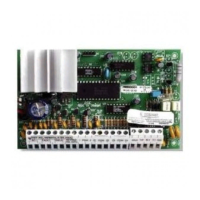22
[18] Stay Armed Status
When the system is armed in the Stay mode, the PGM output
will activate at the beginning of the exit delay. The output
deactivates when the panel is disarmed.
[19] [*][7][1] Command Output Option #1
[20] [*][7][2] Command Output Option #2
These outputs are user-initiated by entering [*][7][1-2] at any
keypad. When any output is activated, three acknowledg-
ment beeps are sounded.
NOTES on Option [20] [*][7][2]:
Press [*][7][2][Access Code, if required] to activate any out-
put programmed as one of PGM output option [03] or [20].
Traditionally, [*][7][2] has been reserved for resetting smoke
detectors. Smoke detectors should now be programmed as
output [03] “Sensor Reset”.
NOTE: Only ONE of options [03] Sensor Reset and
[20][*][7][2] Command Output Option #2 may be programmed
on the same system.
[21]-[24] For Future Use
For Future UseFor Future Use[26] Battery Test (PGM1
only)
When the panel performs the 10-second battery check, the
Battery Test output will activate. You may use this output type
to switch a 20 ohm load across to test the battery for the 10
second battery check period. Connect a resistor between the
Bell+ and PGM1 terminals.
[27] Police Code
When a Police Code event occurs, this output will activate
until the panel is disarmed or an access code is entered.
(See “Cross Zone Police Reporting Code”.)
[28] Holdup
When a Holdup zone (zone type [12]) goes into alarm, this
output will activate until the panel is disarmed or an access
code is entered. A tamper or fault on a Holdup zone will not
cause Holdup outputs to activate.
[29] Zone Follower
Outputs programmed this way will be active when pro-
grammed zones are violated. The Output Attributes deter-
mine which zones the output will follow. The output will not
activate for zone types (22) or (23) if DEOL is enabled.
Example: PGM 1 is programmed as a zone follower with
attributes 1, 6, and 8 on. PGM1 will activate when any of
zones 1, 6, or 8 are violated. PGM1 will deactivate when all
three zones are restored.
NOTE: Zone follower outputs cannot be inverted.
Attribute.... ON OFF
[1] ....... Follows zone 1 Does not follow zone 1
[2] ....... Follows zone 2 Does not follow zone 2
[3] ....... Follows zone 3 Does not follow zone 3
[4] ....... Follows zone 4 Does not follow zone 4
[5] ....... Follows zone 5 Does not follow zone 5
[6] ....... Follows zone 6 Does not follow zone 6
[7] ....... Follows zone 7 Does not follow zone 7
[8] ....... Follows zone 8 Does not follow zone 8
PGM Output Attributes
In addition to programming the output type, you must also
program the PGM output attributes for each output. PGM out-
put options [09] “System Trouble”, [10] “System Event” and
[29] “Zone Follower” have their own unique set of attributes
listed below the description of each output type.
PGM output options [01], [03], [05]-[08], [11]-[28] have the
following attributes:
Attribute ....ON OFF
[1] .......Output Enabled Disabled
[3] .......True Output Inverted Output
Attribute ON: the output energizes when acti-
vated
Attribute OFF: the output de-energizes when
activated
[4] .......Output Pulsed Output ON/OFF
Attribute ON: the output will activate once for the
amount of time programmed in section [164]
when initiated by the user
Attribute OFF: the output will toggle ON or OFF
when initiated by the user.
(Only applicable to options [19]-[20].)
[5] .......Access Code Req. No code Req.
Attribute ON: the output requires a code for acti-
vation.
Attribute OFF: no code required.
(only applicable to keypad-activated outputs)
PGM attributes return to their default settings when you
change PGM output options. Please see the programming
worksheets for a list of the default settings for each PGM out-
put type.
Care should be taken in selecting the normal and active
states of each PGM output to ensure that an undesirable out-
put state does not occur after a loss and restore of AC power.
NOTE: Attribute [3] must be ON (default) for PGM output
option [16].
NOTE: If you program more than one PGM output as the
same output type (e.g. if PGM1 and PGM2 are both pro-
grammed as [19] Command Output 1), the settings for output
attributes [1], [2] and [5] must be the same. This does not
apply to outputs programmed as types [09] and [10].
PGM Output Attributes . . . . . . . . . . . . . . Section [141]-[142]
5.12 Telephone Line Monitor (TLM)
When the TLM Enable option is selected, the panel will
supervise the telephone line and will indicate a trouble condi-
tion if the telephone line is disconnected.
If the TLM Enable option is ON, the panel will check the tele-
phone line every 10 seconds. If the telephone line voltage is
below 3V for the number of checks programmed in the TLM
Trouble Delay section, the panel will report a TLM trouble.
The default number of checks is 3. Enter a number from [003]
to [255] in the TLM Trouble Delay section to change the num-
ber of checks before the TLM trouble is reported. Program-
ming a delay means that a momentary interruption of the
telephone line will not cause a trouble condition.
If the TLM Trouble Beeps When Armed option is enabled,
the panel will indicate a TLM trouble at the keypad while the
system is armed. To activate the bell output in the case of a
TLM trouble while the system is armed, the TLM Audible
(Bell) When Armed option must be selected.
When the trouble condition is restored, the panel can send a
TLM Restoral reporting code. Any events which occur while
the telephone line is down will also be communicated. If the
GSM1000 Cellular Communicator is being used the panel can
be programmed to report a TLM Trouble Reporting Code.

